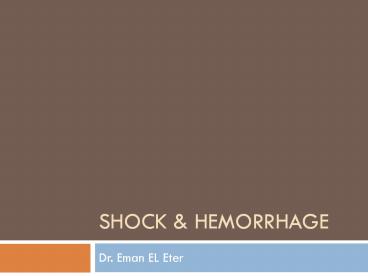Shock - PowerPoint PPT Presentation
Title:
Shock
Description:
SHOCK & HEMORRHAGE Dr. Eman EL Eter Objectives By the end of this lecture the students are expected to: Define circulatory shock. List types and causes of shock. – PowerPoint PPT presentation
Number of Views:132
Avg rating:3.0/5.0
Title: Shock
1
Shock Hemorrhage
- Dr. Eman EL Eter
2
Objectives
- By the end of this lecture the students are
expected to - Define circulatory shock.
- List types and causes of shock.
- Understand the body compensatory mechanisms
during the reversible phase of hemorrhagic
shock. - Understands the mechanisms responsible for the
irreversible phase of hemorrhagic shock
3
Definition
- Inadequate tissue perfusion with relatively or
absolutely inadequate cardiac output.
4
Types causes
- Hypovolemic shock
- Distributive shock.
- Cardiogenic shock.
- Obstructive shock.
5
Types causes, continued
- Hypovolemic shock
- -Loss of blood volume due to
- Hemorrhage.
- Trauma.
- Surgery.
- -Fluid loss due to
- Severe vomiting or diarrhea.
- -Plasma loss
- As in burns.
6
Types causes, continued
- Distributive shock
- (also called vasogenic, low resistance shock)
There is marked vasodilation caused by - Anaphylaxis (due to antigen-antibody reaction,
e.g drug induced..) - Sepsis.
- Neurogenic
- Vasovagal, acute venous dilation,
7
Types causes, cont.,
- Cardiogenic shock
- Results from inadequate output caused by diseased
heart - Myocardial infarction.
- Congestive heart failure.
- Arrhythmias.
8
Types causes, continued
- Obstructive shock
- Due to obstruction to the flow of the blood
- Tension pneumothorax.
- Pulmonary embolism.
9
Pathophysiology of hypovolemic shock
- Characterized by
- Hypotension
- Rapid thready pulse.
- Cold, pale skin.
- Intense thirst.
- Rapid respiration.
- Restlessness.
- According to the cause hypovolemic shock is
subdivided into hemorrhagic, traumatic,
surgical, burn shock.
10
Pathophysiology of hypovolemic shock, cont.,.
- Stages of shock
- Reversible stage.
- In which compensatory reactions appropriate
treatment help restoration of blood pressure
blood loss. - Irreversible stage.
- In which series of positive feed back
mechanisms take place leading to further
deterioration tissue hypoxia. This depends on
amount of blood lost. When blood loss is excess
and not immediately replaced and proper treatment
is delayed, this stage is reached and patient
die. There is also failure of compensatory
mechanisms.
11
Reversible stage
- Characterized by compensatory reactions
- A. Rapid compensatory reactions.
- (act within seconds-minutes).
- B. Responses Activated within hours
- C. Responses activated from hours-days
12
Pathophysiology of hypovolemic shock, Reversible
stage, cont.,
- A. Rapid compensatory reactions
- i. Vasoconstriction this increases TPR and hence
ABP. It is produced by - Baroreceptor refelexes.
- Chemoreceptor reflex.
- Vasopressin-vasoconstrictor mechanism.
- Noreadrenaline-adrenaline vasoconstrictor
mechanism (due to activation of adrenal medulla). - Vasoconstriction is marked in
- Skin cold, pale.
- kidneys drop in GFR urine volume.
- Viscera.
- Heart and brain are spared.
13
Reversible stage in response to heamorrage,
cont,
- ii. Tachycardia
- Produced by
- Baroreceptor reflex.
- Chemoreceptor reflex.
- Increased sympathetic activity.
- iii. Venoconstriction
- Caused by sympathetic activity. It is important
to - Maintain filling pressure of the heart.
- Shift blood from reservoirs into the circulation.
14
Reversible stage, continued.
- iv. Tachypnea
- Caused by activation of chemoreceptor reflex
and sympathetic over activity. - Imporatance
- Increase O2 delivery.
- Increase thoracic pump activity.help VR.
15
Reversible stage, continued,
- V. Restlessness due to sympathetic
overactivity. - This increases sk. Ms. Pump activity.
- vi. Release of vasoconstrictor factors/hormones
- Catecholamines by adrenal medulla.
- Vasopressin (antidiuretic hormone) by posterior
pituitary causes vasoconstriction and restores
fluid volume by reducing urine output. - Renin-angiotensin-aldosterone. (preserve salt and
water).
16
Reversible stage, continued,..
- B. Responses Activated within hours
- Increased movement of interstitial fluid into
capillaries (capillary fluid shift). - Increased secretion of glucocorticoids by adrenal
cortex. (help to maintain blood sugar) - Increased 2,3 DPG concentration in RBCs
important to help HB deliver more O2 to the
tissues (shift O2 dissociation curve to the right)
17
Reversible stage, continued,
- C. Responses activated in hours-days
- Restoration of circulatory plasma volume. Takes
12-72 hrs after moderate hemorrhage. - Restoration of plasma proteins occur in 2
stages - 1. Rapid entry of preformed albumin from
extracellular stores. - 2. Hepatic synthesis of proteins over 3-4 days.
- Restoration of RBCs
18
Reversible stage, continued,..
- Restoration of RBCs
- 1. increase RBCs count in response to
erythropoeitin within 10 days. - 2. restroration of red cell mass within 4-8 weeks.
19
Irreversible stage
- ve feedback mechanisms lead to drop in CO
- 1. Cardiac depression.
- The drop in APB leads to drop in coronary
- flow (-) heart drop
CO - 2. Vasomotor failure.
- Results from depression of vasomotor center,
the heart becomes depressed and CO drops.
20
Irreversible stage
- 3. Release of toxins by ischemic tissues.
- e.g. histamine, tissue enzymes, potassium, ...
- 4. Endotoxin
- Released from gram ve bacteria when blood flow
to intestine decreases absorption of toxins
Cardiac depression.
21
Irreversible stage
- 5. Generalized cellular deterioration
- (-) of mitochondrial activity inside the cells
lead to decrease in ATP. - (-) of cellular metabolism, especially glucose.
- Rupture of many lysosomes.
- Drop in active transport of Na and K across the
cell Na accumulate inside the cell.
22
Summary of compensatory mechanisms of hypovolemic
shock































